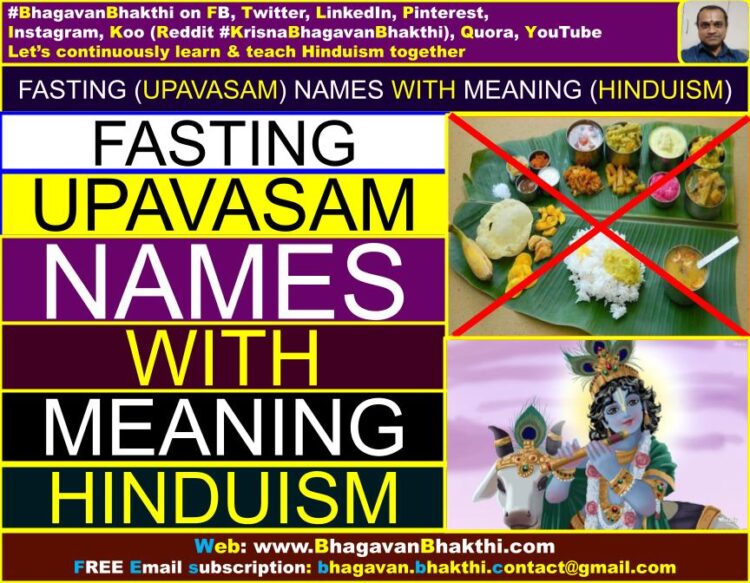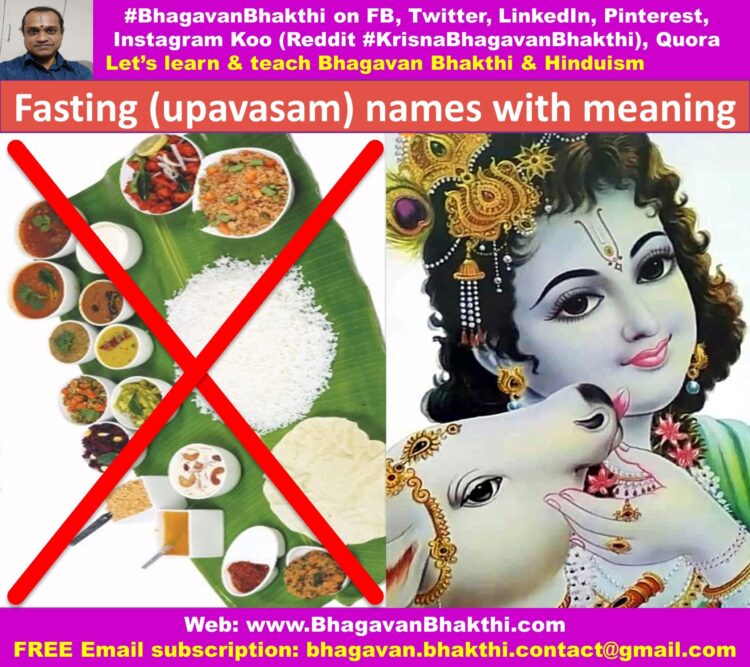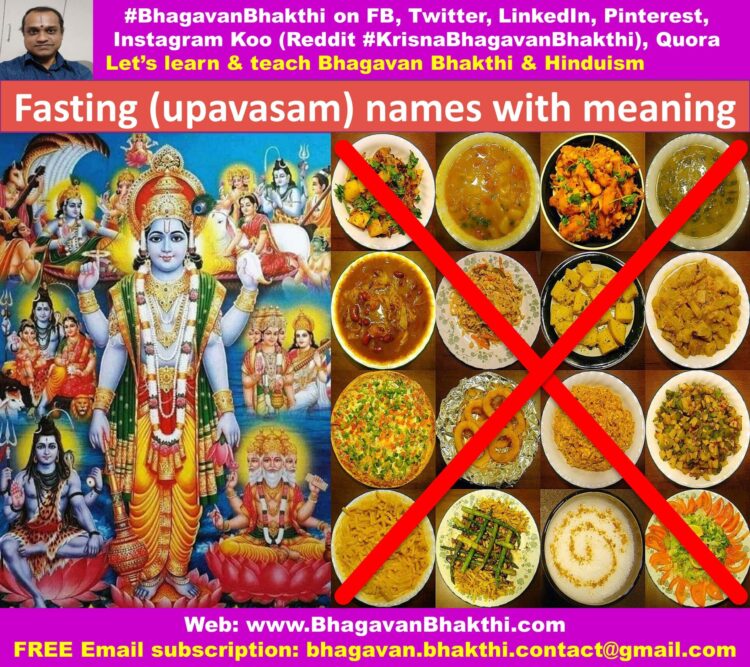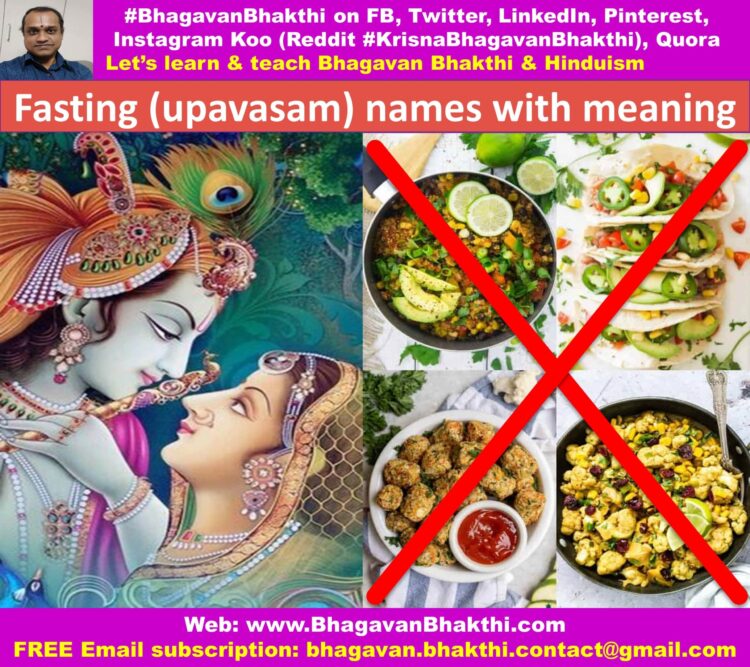List of Fasting (Upavasam) Names with meaning (Hinduism) | How many fasts (types) are there in Hinduism? | What is 40 days fasting in Hinduism? | What is the most powerful fasting in Hinduism? | Hindu fasting month (rules) | Which day is good for fasting in Hinduism | What is Hindu fasting called
Namaste friends, how are you doing today? Welcome to #BhagavanBhakthi website / blog.
Bhagavan Lord Sri Vishnu (Krishna, Rama, Trivikrama, Narasimha, Vamana, Vasudeva, Mukunda) and Goddess Lakshmi (Rukmini, Satyabhama, Sita, Kamala, Maya) blessings to you and your family!
In this website / blog, you will always learn about #Hinduism #Sanskrit language.
Also subscribe to my YouTube channel from this link #BhagavanBhakthi to view videos about #Hinduism #Sanskrit language.
Just before going to “Fasting (Upavasam) Names with meaning (Hinduism) | How many fasts (types) are there in Hinduism? | What is 40 days fasting in Hinduism? | What is the most powerful fasting in Hinduism? | Hindu fasting month (rules) | Which day is good for fasting in Hinduism | What is Hindu fasting called“, let us have a brief some brief information.

First of all, let us understand, what is fasting (upavasam) as per Hindu Sanatana Dharma?
The meaning of “Upavasam” is that one should stay away from the banned things and should always think and only do the works which will make Bhagavan Sri Vishnu happy.
No bhoga (luxury, lust etc.) things should be done on the fasting (upavasam) day(s). Only things related to Bhagavan Sri Vishnu should be done, like reading about the Sanatana Dharma grantas (especially related to Lord Bhagavan Sri Vishnu), listening the pastimes of Sri Hari etc.
During the fasting (upavasam) day(s), one should avoid over eating, applying oil on any part of the body, sleeping during day time, drinking lots of water etc.
On the Great Ekadashi day, one should not have the teertha more than once (remember only teertha can be taken that too only once and that too very very limited),
violence, enmity, talking untruth, eating taambulam (beetle leaves), sleeping during day time, sambhoga, gambling, are all completely forbidden.

If one does the gargling Ekadashi day (12 times) it is considered as brushing the teeth on the Ekadashi day on the day(s) of fasting (upavasam), one should not eat food too much, that is –
on Dashami day one should eat only once, on Ekadashi day complete fasting and also on the Dwadashi day only once food has to be taken.
If someone dies on the Ekadashi day, the Shraddha of that person should be done on the Dwadashi day (please consult a correct Vaishnava Brahmin to know more).
During the Dwadashi day, if one can’t do the Parana sadhana because of the some unexpected reasons, then that person can have some water to complete the fasta (upavasam) vrata.
[Remember the King Ambarisha Maharaja’s story – when Durvasa Muni comes to meet King Ambarisha Maharaja unexpectedly, at the time Ambarisha Maharaja consumes little bit of water to complete fasting (upavasam) vrata.]

The different types of fasting (upavasam) names are as given below:
1. ekabhukta : Ēkabhukta (एकभुक्त) – Here eka means one, bhukta means leaving – this means leaving one time’s food.
2. dravaahaara : Dravāhāra (द्रवाहार) – Here drava means liquid and ahaara means food – this means having only liquid foods.
3. phalaahaara : Phalāhāra (फालाहार) – Here phala means fruits and ahaara means food – this means having only fruits as food.
4. vihitaahaara : Vihitāhāra (विहिताहार) – Here vihita means allowed and ahaara means food – this means having only allowed foods.
5. mitaahaara : Mitāhāra (मिताहार) – Here mita means limited and ahaara means food – this means having only limited food.
6. niraahaara : Nirāhāra (निराहार) – Here nira means not at all having and ahaara means food – this means having nothing (including water). The other name of ‘niraahaara’ is ‘nirjala’ means doing fasting (upavasam) even by not consuming a drop of water.
Among the above said upavasam doing the ‘niraahaara or ‘nirjala’ upavasam is the best and this will ultimately yield us the best fruits.

(Just for example – If a student studies through out the year in the right way, then that student will get very very good marks or may be 100 out of 100.)
(Similarly someone studies only half means, that student will get average marks and also a student who studies nothing or very little means that student get just pass marks or he / she may get failed in the examination also.)
(Remember if we need to be more closer means we need to perform our Dharma’s duties properly, rightly, with full bhakti, with full respect, then only we will get more and more marks otherwise we will get marks as per our qualification and capacity. Everything is left to us.)
More information will be added to this on regular basis. Please this post and other posts of this website / blog to get the updated information.
To watch videos on #Hinduism #Sanskrit language, SUBSCRIBE to my YouTube channel from this link: #BhagavanBhakthi YouTube channel
To know more about Bhagavad Gita, please visit this link: Bhagavad Gita on Bhagavan Bhakthi
To get more knowledge about Ekadashi and fasting, visit this link: What is Ekadashi fasting meaning and importance
Dear friends, if you need any clarifications about this post, kindly let me know, I will definitely try to answer all of them.
Also your one LIKE, one COMMENT, One Share, one SUBSCRIPTION is highly important.
This will help to know the quality of this content and also it will be helpful to know if any improvements is required for the content.
If you feel this content is useful to you and has helped you to improve your knowledge, kindly share this with your well-wishers.
Because “SHARING MEANS CARING”.
To receive FREE EMAIL SUBSCRIPTION about #BhagavanBhakthi, you can send an email to bhagavan.bhakthi.contact@gmail.com from your email ID.
NAMASTE!
Sri Gurubhyo Namaha
Sri Krishnaaya Namaha
Sri Krishnaarpanamastu
Share in Social Media